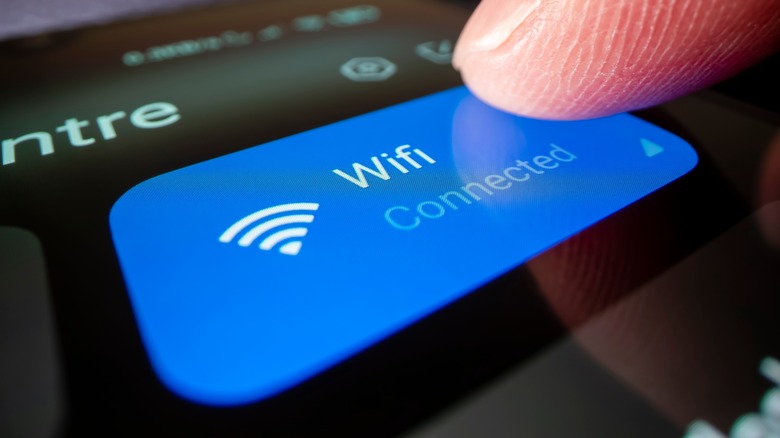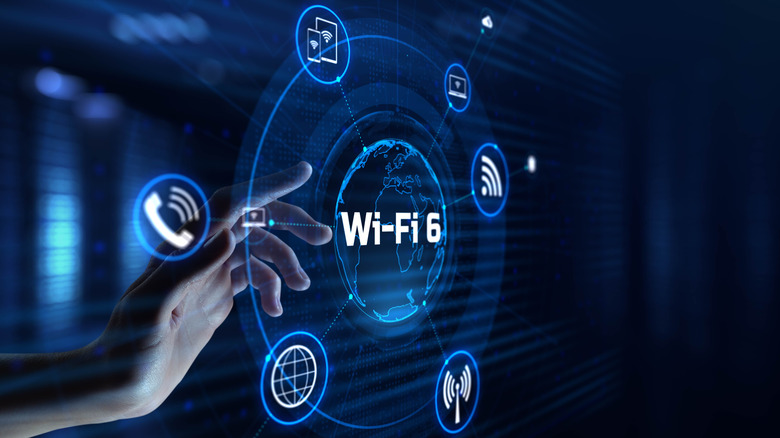Wi-Fi 5 Vs Wi-Fi 6: What's The Big Difference?
Much like cellular internet goes through generational upgrades — 3G, 4G, 5G — so does wireless networking technology. You may have heard people refer to these generations by their titles, like Wi-Fi 5 and Wi-Fi 6, and wondered what the difference is. Making things more confusing are titles like Wi-Fi 6E, and while we're on the subject, is Wi-Fi 7 ever coming?
Let's start with what Wi-Fi actually is. As its capitalized spelling suggests, Wi-Fi is a registered trademark of a nonprofit consortium called the Wi-Fi Alliance. The term refers to variants of the 802.11 wireless networking standard, which is maintained by the Institute of Electrical and Electronics Engineers Standards Association. Thanks to these agreed-upon and maintained specifications, Wi-Fi has the benefit of interoperability, meaning that all the wirelessly networked devices in your home can communicate with it.
At the most basic level, each generation of Wi-Fi is faster and has more bandwidth than its predecessor while operating on the latest version of the 802.11 wireless protocol. For you as a consumer, this means more robust connectivity, the ability to stream and download with greater ease, and breathing room for the increasing number of connected devices we're cramming into our homes, from gaming consoles to smart fridges.
What are the differences between Wi-Fi 5 and 6?
The previous generation of 802.11 connectivity, Wi-Fi 5, was introduced in 2013 and saw wide adoption by the following year. It operates on the 802.11ac standard and offers speeds up to 3.5 gigabits per second (Gbps). When it was released, our lives were becoming increasingly Internet-centric, so it offered a massive leap in speed to accommodate game consoles, smart TVs, and all the other gadgets that were becoming commonplace at the time.
Wi-Fi 6, by contrast, was introduced in 2019. It operates on the 802.11ax wireless standard and offers speeds up to 9.6 Gbps. By the time it was released, the Internet of Things had arrived, so there was a heightened focus on supporting multiuser modes to accommodate different smart gadgets. Additionally, it supported both the 2.4 GHz and 5 GHz frequency bands. It was a quantum leap forward over the previous generation.
There's really no reason to purchase a Wi-Fi 5 router these days since Wi-Fi 6 and the needs of a rapidly evolving, internet-connected household have rendered it essentially obsolete. Meanwhile, with Wi-Fi 6E already out and Wi-Fi 7 beginning to enter the market, Wi-Fi 6 is starting to be left behind as well.
What are Wi-Fi 6E and Wi-Fi 7?
In 2020, the year after Wi-Fi 6 was released, an upgrade was introduced with Wi-Fi 6E. The E stands for extended, as this version of the protocol supports the ultra-fast 6Ghz frequency band, which gives routers a larger band of frequencies to broadcast. This change was made to help ease spectrum congestion — in other words, to make sure that you can connect more devices to your router without any of them getting booted off or slowed down.
The latest version of Wi-Fi is Wi-Fi 7, which promises the biggest leap forward in speeds yet and is already starting to hit the market. In addition to supporting 2.4 GHz and dual-channel 5 GHz frequencies, Wi-Fi 7 supports the 6 GHz band. It also increases channel width to 320 MHz, which is double the capacity of Wi-Fi 6. Combined, those improvements deliver theoretical speeds up to an eye-watering 46 Gbps.
Though you'll be hard-pressed to find a consumer product capable of taking advantage of such ludicrous speed, Wi-Fi 7 will make life a lot easier for those with extensive smart home setups when that speed is combined with the increase in bandwidth. Some internet providers seem ready to go all-in on supporting Wi-Fi 7, with Google Fiber announcing 20-gigabit speeds that will require a Wi-Fi 7 router to take advantage of.


